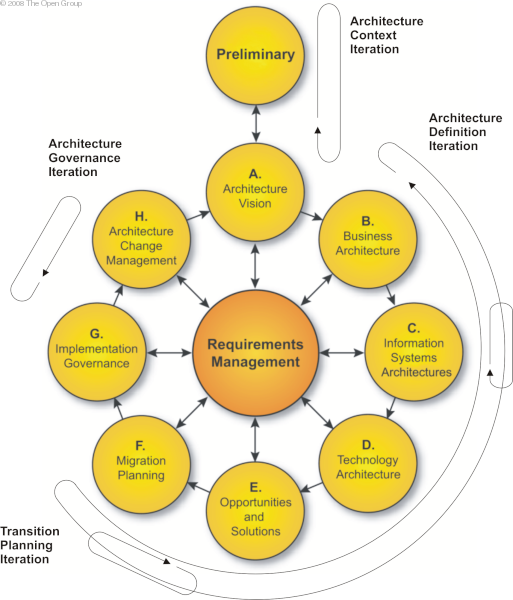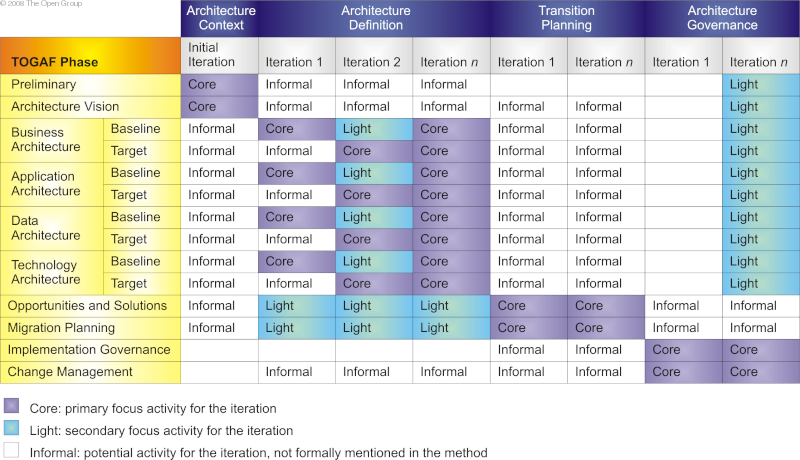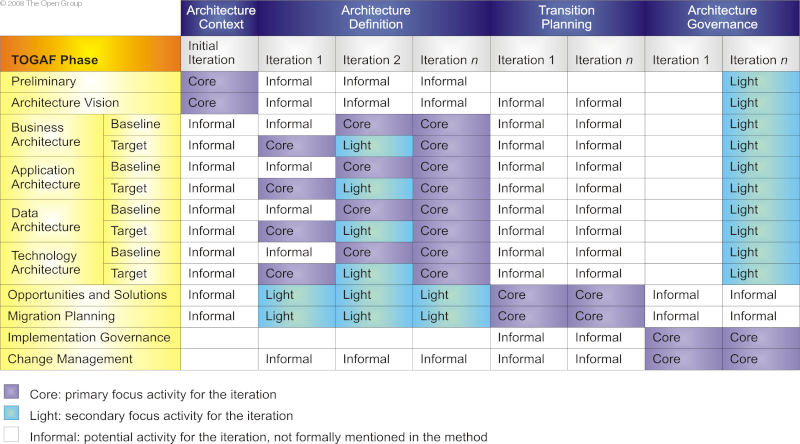Overview
The Architecture Development Method (ADM) is a flexible process that can be used to support the development of
architecture as a stand-alone process, or as an extension to other solution development or project management methods.
Many organizational factors will influence the extent to which the ADM should be used in an iterative fashion.
Particular factors for consideration would include:
-
The formality and nature of established process checkpoints within the organization. Does the organization
mandate that certain groups of activities are carried out between checkpoints? Does the organization mandate that
certain activities must be finalized before other activities can be carried out?
-
The level of stakeholder involvement expected within the process. Are stakeholders expecting to be closely
involved within the development of a solution, or are they expecting to see a complete set of deliverables for
review and approval?
-
The number of teams involved and the relationships between different teams. Is the entire architecture being
developed by a specific team, or is there a hierarchy of teams with governance relationships between them?
-
The maturity of the solution area and the expected amount of re-work and refinement required to arrive at an
acceptable solution. Can the solution be achieved in a single pass, or does it require extensive
proof-of-concept and prototyping work to evolve a suitable outcome?
-
Attitude to risk. Does the organizational culture react negatively to partially complete work products being
circulated? Does the organizational culture require solutions to be proved in a trial environment before they can
be implemented for mainstream application?
The ADM supports a number of concepts that could be characterized as iteration. It is expected that:
-
Project teams will iterate through the entire ADM cycle, commencing new vision activity as a result of Architecture
Change Management.
-
Project teams may cycle between ADM phases, in planned cycles covering multiple phases (e.g., Business
Architecture, Information Systems Architecture, Technology Architecture).
-
Project teams may return to previous phases in order to circle back and update work products with new information.
-
Many project teams may operate their own ADM cycles concurrently, with relationships between different teams. For
example, one architecture team may trigger a request for work for another architecture team.
All of these techniques are valid applications of the ADM and can be used to ensure that the approach to architecture
development is sufficiently flexible to accommodate other methods and frameworks.
Iteration Cycles
When considering planned iteration cycles that span a number of ADM phases, the following guidelines can be used to
effectively group related architectural activities to achieve a specific purpose.
These ADM iteration cycles are intended to span multiple phases of activity and allow formal review upon completion of
each multi-phase iteration cycle (for example, an Architecture Definition should be reviewed with visibility of the
Business, Data, Application, and Technology Architectures, rather than in isolation).
The suggested iteration cycles are shown in Iteration Cycles.
 Figure: Iteration Cycles
Figure: Iteration Cycles
-
Architecture Context iterations allow initial mobilization of architecture activity by establishing the
architecture approach, principles, scope, and vision.
-
Architecture Definition iterations allow the creation of architecture content by cycling through Business,
Information Systems, and Technology Architecture phases. These iterations also allow viability and feasibility
tests to be carried out by looking at opportunities and migration planning.
-
Transition Planning iterations support the creation of formal change roadmaps for a defined architecture.
-
Architecture Governance iterations support governance of change activity progressing towards a defined
Target Architecture.
Some iteration cycles can be executed once, whereas others have a natural minimum number of cycles. For some iteration
cycles, each iteration follows the same process; where there is more than one iteration within a cycle, the process
differs slightly for each of the iterations.
When considering the usage of iteration cycles, it is also necessary to consider where to place appropriate checkpoints
within the process. If the expected level of stakeholder involvement is high, it may be sensible to carry out very
frequent but informal checkpoints to ensure that the process is moving in the intended direction. If stakeholders are
less closely involved, then checkpoints may be less frequent but more formal. Checkpoints at the completion of each
iteration cycle, or at the end of several iteration cycles, are common.
Two Styles of Architecture Definition
Two process styles can be adopted within the ADM for the definition of architectures:
-
Baseline First: In this style, an assessment of the baseline (i.e., current state) landscape is used to
identify problem areas and improvement opportunities. This process is suitable when a target solution is not
clearly understood and agreed upon.
-
Target First: In this style, the target solution is elaborated in detail and then mapped back to the
baseline, in order to identify change activity. This process is suitable when a target state is agreed at a high
level and where the enterprise wishes to avoid proliferating current business practice into the target model.
The rationale for these two styles is that, in many cases, consideration of the target is deferred until conclusions
have been made on the baseline. Premature consideration in these situations may be disruptive or politically sensitive
(because the Target Architecture influences organization, roles, and responsibilities). Equally, initiatives that are
examining Target Architectures run the risk of being constrained by the baseline or appearing to be constrained by the
baseline if significant time is spent examining existing solutions.
In practical terms, an architecture team will always give informal consideration to the baseline when analyzing the
target (and vice versa). In situations where baseline and target are expected to be considered in parallel by
stakeholders, it is recommended that the architecture team focuses priority on one state within the internal structure
of that engagement in order to maintain focus and consistency of execution.
Mapping TOGAF Phases to Iteration Cycles
Each iteration cycle crosses multiple TOGAF ADM phases. The following tables show at a high level which phases should
be completed for which iteration cycle, showing activity that is core (i.e., the primary focus of the iteration),
activity that is light (i.e., the secondary focus of the iteration), and activity that may be informally conducted
(i.e., some activity may be carried out, but it is not explicitly mentioned in the ADM).
 Figure: Activity by Iteration for Baseline First Architecture Definition
Figure: Activity by Iteration for Baseline First Architecture Definition
 Figure: Activity by Iteration for Target First Architecture Definition
Figure: Activity by Iteration for Target First Architecture Definition
|
Iteration Cycle
|
Iteration
|
Purpose
|
Description
|
|
Architecture Context
|
Initial Iteration
|
Establish the approach, principles, scope, and vision for the engagement.
|
This iteration comprises a pass through the Preliminary and Architecture Vision phases of the ADM.
|
|
Architecture Definition (Baseline First)
|
Iteration 1
|
Define the Baseline Architecture.
|
This iteration comprises a pass through the Business Architecture, Information Systems
Architecture, and Technology Architecture phases of the ADM, focusing on definition of the
baseline.
Opportunities, solutions, and migration plans are also considered to drive out the focus for change
and test feasibility.
|
|
|
Iteration 2
|
Define the Target Architecture and gaps.
|
This iteration comprises a pass through the Business Architecture, Information Systems
Architecture, and Technology Architecture phases of the ADM, focusing on definition of the target
and analyzing gaps against the baseline.
Opportunities, solutions, and migration plans are also considered to test viability.
|
|
|
Iteration n
|
Refine baseline, target, and gaps.
|
Subsequent Architecture Definitions attempt to correct and refine the target to achieve an outcome
that is beneficial, feasible, and viable.
|
|
Architecture Definition (Target First)
|
Iteration 1
|
Define the Target Architecture.
|
This iteration comprises a pass through the Business Architecture, Information Systems
Architecture, and Technology Architecture phases of the ADM, focusing on definition of the target.
Opportunities, solutions, and migration plans are also considered to drive out the focus for change
and test feasibility.
|
|
|
Iteration 2
|
Define the Baseline Architecture and gaps.
|
This iteration comprises a pass through the Business Architecture, Information Systems
Architecture, and Technology Architecture phases of the ADM, focusing on definition of the baseline
and analyzing gaps against the target.
Opportunities, solutions, and migration plans are also considered to test viability.
|
|
|
Iteration n
|
Refine baseline, target, and gaps.
|
Subsequent Architecture Definitions attempt to correct and refine the target to achieve an outcome
that is beneficial, feasible, and viable.
|
|
Transition Planning
|
Iteration 1
|
Define and agree a set of improvement opportunities, aligned against a provisional Transition
Architecture.
|
The initial iteration of transition planning seeks to gain buy-in to a portfolio of solution
opportunities in the Opportunities & Solutions phase of ADM.
This iteration also delivers a provisional Migration Plan.
|
|
|
Iteration n
|
Agree the Transition Architecture, refining the identified improvement opportunities to fit.
|
Subsequent iterations of Transition Planning seek to refine the migration plan, feeding back issues
into the Opportunities & Solutions phase for refinement.
|
|
Architecture Governance
|
Iteration 1
|
Mobilize architecture governance and change management processes.
|
The initial Architecture Governance iteration establishes a process for governance of change and
also puts in place the appropriate people, processes, and technology to support managed access to
and change of the defined architecture.
|
|
|
Iteration n
|
Carry out architecture governance and change control.
|
Subsequent iterations of the Architecture Governance cycle focus on period reviews of change
initiatives to resolve issues and ensure compliance.
|
|


